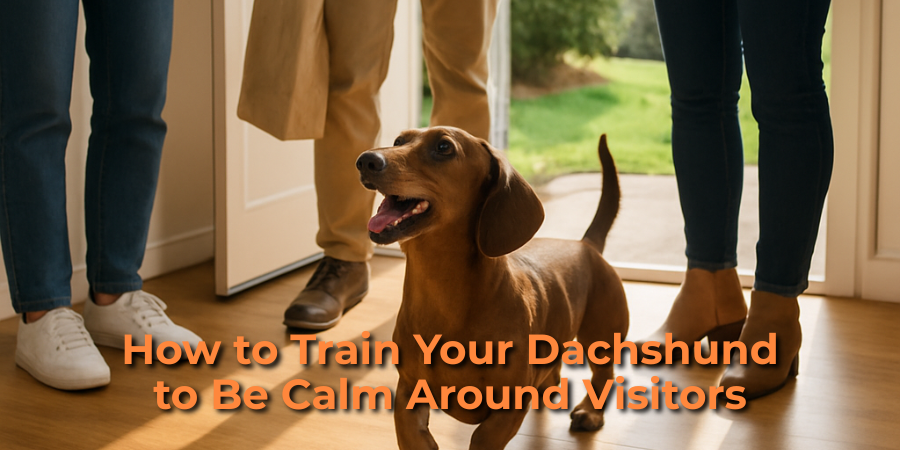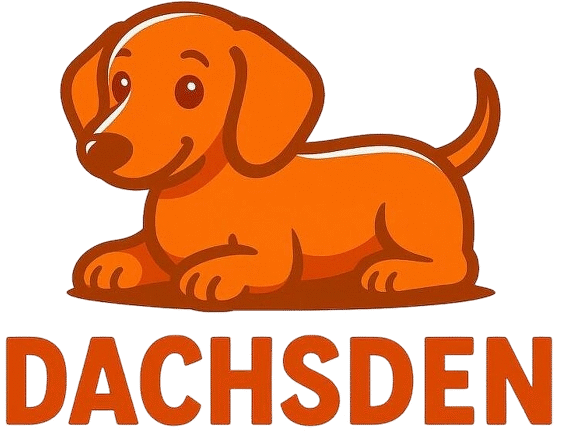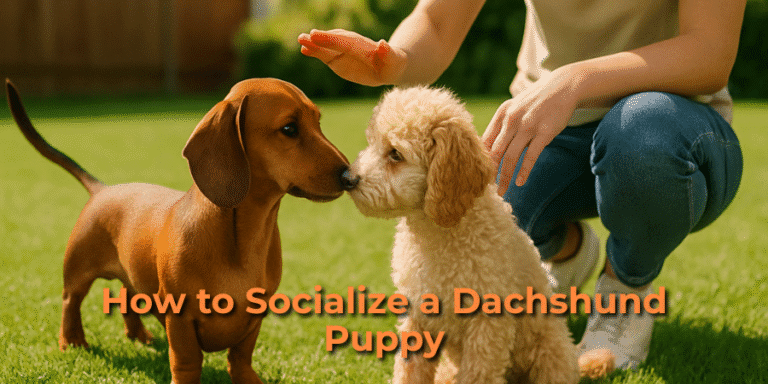How to Train Your Dachshund to Be Calm Around Visitors (Without the Chaos)
Dachshunds are among the best dogs and make excellent pets, but their protective nature often leads to barking and excitement when guests arrive. Our dachshund showed anxious tendencies, territorial traits, and resource guarding, making it a challenging journey we’ve been working on for 7 years. It’s not impossible to solve, but it takes time.
With the right training, your dachshund can stay calm around visitors. It requires patience, consistency, and an understanding of their unique temperament. Some practical tips can help minimise anxiety and create a more welcoming home for everyone. It’s something worth the effort.

How to Train Your Dachshund to Be Calm Around Visitors – Short Answer
To train your Dachshund to be calm around visitors, combine early socialization, consistent positive reinforcement, and structured routines. Reward calm behavior and manage excitement to build lasting, polite habits.
Why Dachshunds React Strongly to Visitors
Dachshunds have a strong instinct to bark, a trait deeply rooted in their history as fearless hunters. They were bred to track, flush, and chase prey like badgers, making barking an essential part of their job. Even today, this instinct remains, making them excellent watchdogs.
Their sharp senses allow them to quickly pick up on unusual sounds or movements—whether it’s a passing squirrel, a knock at the door, or even a leaf blowing down the street—they rarely hesitate to alert you and grab your attention.
But their vocalisations aren’t always a warning of dangers. Often, it’s a mix of excitement, nervousness, or even territoriality, especially around visitors in the home. Some will greet guests with joy, while others signal anxiety, appearing unsure of strangers. Understanding the source of your Dachshund’s barking is the first step in addressing it.
Once you identify if it’s fear, excitement, or their protective nature, you can use focused training techniques to manage the behaviour, while still respecting their natural instincts.
Establish a Calm Greeting Routine
Training your Dachshund to stay calm around visitors starts with creating a predictable and positive structure. Practising a calm greeting routine helps your dog feel safe, know what to expect, and respond appropriately when someone arrives. Below is a breakdown of the steps you can follow, with proven techniques to encourage polite behaviour over barking or jumping.
Step 1: Ignore Excited Behavior
- If your Dachshund starts barking, jumping, or whining when the doorbell rings, do not give any attention right away.
- Ask your guest or family member helping with training to also ignore the dog completely.
- Wait patiently until your dog settles down—this teaches them that only calm behaviour earns attention.
- This step is important to prevent inadvertently reinforcing overexcited reactions during greetings.
Step 2: Reward Calmness with Positive Reinforcement
- Once your dog is calm, reward them with treats or verbal praise.
- Use positive reinforcement to associate quiet behaviour with good outcomes.
- Be consistent—every time someone enters and your Dachshund stays calm, offer the same reward.
- Over time, your dog will strengthen the calm response naturally, even in high-energy moments.
Step 3: Train the “Place” Command
- Choose a specific spot like a mat or bed near the entrance.
- Train your Dachshund to go to that place whenever the doorbell rings.
- Use treats to guide them to the spot and ask them to stay until released.
- This provides your dog with a clear alternative behaviour and gives them a sense of structure and purpose during greetings.
By practising these steps regularly, you’ll not only manage excitement and barking, but also build your Dachshund’s confidence when greeting guests. It transforms chaos into calm using repetition, rewards, and clear expectations—all while respecting your dog’s natural instincts.
Desensitize Doorbell and Knock Triggers
Dachshunds often react strongly to sounds like the doorbell or a knock, viewing them as alerts or territorial threats. But you can train your dog to stay calm using structured desensitization and positive reinforcement. Here’s a shorter guide to make that happen.
Start With Low Volume
- Play doorbell or knock sounds at a low volume while your dog is calm
- Reward your Dachshund with treats or praise for staying quiet
- Repeat daily in short sessions
Slowly Increase Sound Level
- Gradually raise the volume over several days
- If your dog reacts, lower the volume and slow down
- Keep rewarding calmness consistently
Add a Verbal Cue
- Introduce a command like “quiet” or “settle”
- Pair it with rewards to reinforce the behavior
- Use a calm, firm voice so your dog knows what’s expected
Practice With Real-Life Scenarios
- Mix in real doorbell rings or guest knocks over time
- Stick to the same steps: sound, cue, reward
- Be consistent—repetition builds confidence and control
With regular practice, your Dachshund will learn to stay calm when someone’s at the door, making visits more peaceful for everyone.
Burn Excess Energy Before Guests Arrive
Keeping your Dachshund calm around visitors starts long before the doorbell rings. A tired Dachshund is often a calm Dachshund, and spending energy through physical and mental activity is key to promoting relaxed behavior when guests arrive.
Take a Walk or Play
- A good walk, whether it’s a brisk stroll or a longer park outing, helps release built-up energy
- Engage in play like fetch, tug-of-war, or hide-and-seek to burn off excitement
- Physical activity offers a mental reset, making it easier for your Dachshund to stay composed
Use Interactive Toys
- Try puzzle feeders, snuffle mats, or treat-dispensing toys to keep them mentally engaged
- These tools focus your Dachshund’s attention and reduce restlessness
- Regular use promotes a sense of accomplishment and discourages barking or overreacting
By channeling your Dachshund’s natural energy into productive activities, you’ll help them stay balanced and less reactive when visitors show up. This preparation creates a smoother, calmer experience for both your pup and your guests.
Control Initial Excitement During Entry
Sometimes, even after good training, your Dachshund might still get overly excited when guests show up. Using gentle methods to guide their behavior during these high-energy moments can make a big difference in how they respond.
Use a Lead for Calm Control
- When the door opens, keep your Dachshund on a lead to stop them from rushing
- Gently guide them away from the door and help them stay focused
- A controlled introduction helps reinforce calm behaviour during arrivals
Allow Gradual Introduction
- Don’t rush the greeting — let your Dachshund approach visitors at their own pace
- Giving them space helps reduce excitement and prevents them from feeling overwhelmed
- This builds confidence and creates more positive interactions long-term
Using these simple steps, you’ll manage their initial excitement and make sure every guest’s arrival is smoother for both your dog and your home.
Be Consistent with Positive Reinforcement
Dachshunds respond best to positive reinforcement, so when they act calmly around guests, reward them with treats, toys, or praise. This helps them associate their good behaviour with positive outcomes. Over time, the more consistently you reinforce calmness, the stronger and more natural the response becomes.
Consistency is key — if family members follow different approaches, it can be confusing for your dog. Make sure everyone sticks to the same training routine when it comes to greetings and rewards—especially when dealing with breeds that may test your patience, like this one.
This way, your Dachshund will quickly understand what’s expected and be more likely to maintain calm behaviour when visitors arrive.
Create a Safe Space for Overwhelmed Dogs
If your dachshund shows signs of anxiety when visitors come over, creating a quiet, comfortable space can help them feel more secure. A crate or a separate room with their bed, toys, and familiar scents gives them a safe retreat to relax, unwind, and avoid feeling overwhelmed by the commotion.
Incorporating crate training into your regular routine offers long-term benefits. By helping your dachshund associate this designated space with positive experiences—like a favorite treat, chew, or toy—you make it a place of reward, not isolation. Over time, this positive association builds trust and helps reduce stress, making your dog feel calm and at ease when the home gets busy.
Socialize Early and Often
Socializing your Dachshund early and often is key to raising a confident, well-behaved dog. During puppyhood, frequent exposure to different people, settings, and sounds helps reduce stranger anxiety and teaches your pup that new environments are nothing to fear—something best started with early exposure methods.
By introducing your dog to various experiences at a young age, and consistently reinforcing positive reactions with praise or treats, you help build their comfort and trust. This foundational socialization leads to smoother interactions with visitors later in life and supports your Dachshund in becoming a friendly, calm companion.
Know When to Call in a Professional
If your dachshund’s barking or anxiety is still severe after consistent training, it may be time to consult a professional dog trainer or behaviourist. These experts can develop personalised strategies to address your dog’s unique needs and guide you more effectively through the process.
With continued patience and consistency, your dachshund can learn to stay calm when visitors arrive. By understanding their behaviour, practising greetings, and rewarding every positive action, you’ll help shape a more composed companion who may eventually enjoy the attention guests bring rather than viewing them as a cause for alarm.
Final Thoughts
Training a calm Dachshund takes patience, time, and consistency, but the payoff is huge. A well-behaved, guest-friendly companion brings peace to your home and makes every visit smoother and more enjoyable.
With ongoing practice, positive behaviour becomes second nature—especially when built on foundations like structured behavior training. Keep going, and remember—the rewards of your effort will show in a dog who’s not only calm but confident and welcoming.
FAQ’s
How do I get my dog to calm down around guests?
Before guests arrive, give your dog plenty of exercise and mental stimulation to help them calm down. Use a safe space and distractions, and ask visitors to ignore your dog at first. Reward calm behavior with treats and praise to reinforce positive responses.
How do I stop my dog from being reactive to visitors?
When your dog starts barking as strangers enter, avoid giving it any attention. Wait until your dog calms, then let them out and ask your visitors to completely ignore the dog — no talking, eye contact, or interaction. Let everyone simply coexist in the same space. When the dog shows signs of being calm again, have the visitor gently throw a couple treats without looking directly at them. Then just repeat the process.
Why does my dog go crazy when he sees people?
Excitable behavior around animals and people often means your dog sees every encounter as playtime and can barely contain its excitement. If you’ve allowed others to pet your dog freely or taken it to dog parks and left it unsupervised, these experiences might be the reasons for this overstimulated response.
How do I get my Dachshund to like people?
Let your dachshund puppy meet and interact with people of various ages and genders early on. Getting used to different environments, whether it’s having guests inside the house or meeting new faces outdoors on neutral territory, helps build social confidence and reduces anxiety later in life.







